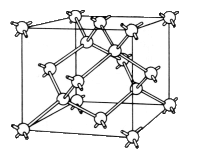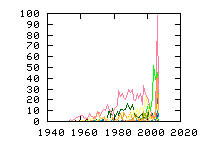« Previous
1
Next »
(7 hits, 1/1)
Showing
10, 25, 50, 100, 500, 1000, all papers per page.
Sort by:
last publication date,
older publication date,
last update date.
- 1. Appl. Phys. Lett. 88, 183506 (2006) , “Deep level transient spectroscopy study of nickel-germanide Schottky barriers on n-type germanium”, E. Simoen, K. Opsomer, C. Claeys, K. Maex, C. Detavernier, R. L. Van Meirhaeghe, S. Forment, and P. ClauwsNickel-germanide Schottky barriers have been made on n-type germanium and evaluated by deep level transient spectroscopy in order to detect possible metal indiffusion during the 30 s rapid thermal annealing (RTA) employed for the germanidation. It is shown that while no electron traps have... (Read more)
- 2. J. Appl. Phys. 100, 124315 (2006) , “Magnetic resonance study of Ni nanoparticles in single-walled carbon nanotube bundles”, A. A. Konchits, F. V. Motsnyi, Yu. N. Petrov, S. P. Kolesnik, V. S. Yefanov, M. L. Terranova, E. Tamburri, S. Orlanducci, V. Sessa, and M. RossiWe present a detailed study of the electron magnetic resonance (EMR) properties of Ni nanoparticles (NPs) placed in the bundles of single-walled carbon nanotubes produced by arc discharge with Ni catalyst. The behavior of EMR signals has been investigated in the 10–300 K temperature range for... (Read more)
- 3. J. Appl. Phys. 99, 043509 (2006) , “Influence of metal trapping on the shape of cavities induced by high energy He+ implantation”, R. El Bouayadi, G. Regula, M. Lancin, B. Pichaud, and M. DesvignesIn He implantation induced cavities highly contaminated with metals (Au, Ni, Pt) we found that, when no three-dimensional structure is observed, the shape of the cavities can be strongly modified depending on the nature of the metal and on its trapped quantity. The equilibrium shape of cavities is... (Read more)
- 4. Solid State Commun. 101, 611-615 (1997) , “Identification of iron transition group trace impurities in GaN bulk crystals by electron paramagnetic resonance”, P. G. Baranov, I. V. Ilyin and E. N. MokhovWe report on the observation of electron paramagnetic resonance of iron, manganese and nickel trace impurities in bulk GaN crystals grown by the sublimation sandwich method. The resolved hyperfine structure due to interaction with 55Mn (I = 5/2) nuclei has been observed in GaN, allowing unambiguous... (Read more)
- 5. Solid State Commun. 73, 393 (1990) , “Electron paramagnetic resonance of nickel in silicon. — I. Identification of spectrum”, L. S. Vlasenko, N. T. Son, A. B. van Oosten, C. A. J. Ammerlaan, A. A. Lebedev, E. S. Taptygov, V. A. KhramtsovResults are reported on the paramagnetic resonance spectrum recently identified with the negatively charged state of substitutional nickel in n-type silicon. Studies were made on the presence of the spectrum in silicon with different concentrations of phosphorus doping and under various conditions... (Read more)
- 6. Appl. Phys. A 30, 1 (1983) , “Transition Metals in Silicon”, E. R. Weber.A review is given on the diffusion, solubility and electrical activity of 3d transition metals in silicon. Transition elements (especially, Cr, Mn, Fe, Co, Ni, and Cu) diffuse interstitially and stay in the interstitial site in thermal equilibrium at the diffusion temperature. The parameters of the liquidus curves are identical for the Si:Ti — Si:Ni melts, indicating comparable silicon-metal interaction for all these elements. Only Cr, Mn, and Fe could be identified in undisturbed interstitial sites after quenching, the others precipitated or formed complexes. The 3d elements can be divided into two groups according to the respective enthalpy of formation of the solid solution. The distinction can arise from different charge states of these impurities at the diffusion temperature. For the interstitial 3d atoms remaining after quenching, reliable energy levels are established from the literature and compared with recent calculations. (Read more)
- 7. Solid State Physics 13, 223-304 (1962) , Academic Press, New York (Edited by F. Seitz, D. Turnbull) , “Electron Spin Resonance in Semiconductors”, G. W. Ludwig, H. H. Woodbury.I. Introduction (p.223): II. The Resonance Technique (p.226): 1. The Spin Hamiltonian (p.226), 2. The Spin Resonance Spectrum (p.231), 3. Experimental Techniques (p.237), III. Resonance Studies in Silicon (p.243): 4. Shallow Donor Impurities (p.244), 5. Shallow Acceptor Impurities (p.259), 6. Transition Metal Ions (p.263), 7. Impurity Pairs (p.273), 8. Radiation Damage Centers (p.280), IV.Resonance Studies in Other Semiconductors (p.286): 9. Germanium (p.286), 10. Graphite and Diamond (p.290), 11. Silicon Carbide (p.293), 12. Indium Antimonide and Gallium Phosphide (p.294), 13. Zinc Sulfide and Related Semiconductors (p.295), Acknowledgments (p.304)
« Previous
1
Next »
(7 hits, 1/1)
Showing
10, 25, 50, 100, 500, 1000, all papers per page.
Sort by:
last publication date,
older publication date,
last update date.
All papers (3399)
Updated at 2010-07-20 16:50:39
Updated at 2010-07-20 16:50:39
(view as: tree
,
cloud
)
| 1329 | untagged |
Materials
(111 tags)
Others(101 tags)
Technique
(46 tags)
Details
(591 tags)
Bond(35 tags)
Defect(interstitial)(18 tags)
Defect(vacancy)(15 tags)
Defect-type(19 tags)
Element(65 tags)
Energy(8 tags)
Isotope(56 tags)
Label(303 tags)
Sample(17 tags)
Spin(8 tags)
Symmetry(15 tags)

